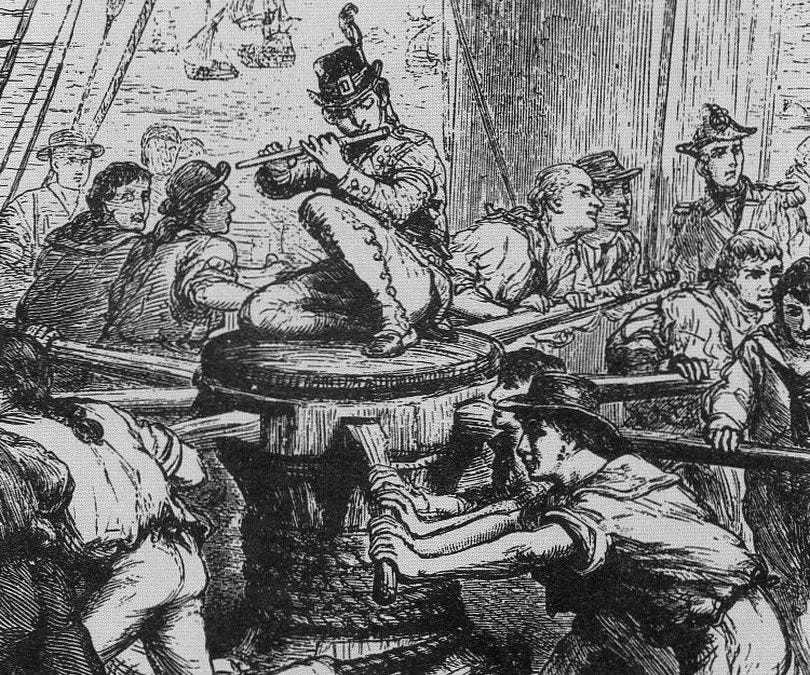Rav Huna said: The song of sailors and ploughmen is permitted, [However, the song] of weavers is forbidden. Rav Huna nullified [all types of] song. The price of one hundred ducks stood at a dinar, and one hundred se’ah of wheat at a dinar, and there was no demand for them [even at such a cheap price]. Rav Ḥisda came [and belittled this prohibition, people began to sing again]. As a result, prices increased greatly, whereby one wanted a single duck for one dinar and it could not be found.
-Babylonian Talmud Sota 48a
Ladies and gentleman, I have an announcement:
The Talmud is pro-sea shanty.
I know, many of you were furtively waiting for these well-loved parts of the folk music tradition to receive a rabbinic blessing. Shanties, like the tides, have been on the rise of late, making their way from boats and pubs into video games and social media.
Reading Tractate Sota, what do we make of Rav Huna’s support of singing sailors? Or his ban on warbling weavers? Or his executive order banning song and its economic fallout? Reckoning with this curious Talmudic passage will lead us on a path through the religious meaning of sea shanties and other work songs in our post-industrial age, as well as the ultimate stakes of song in the rabbinic mind.
Rav Huna’s approval of music to sailors and ploughmen appears due to the fact that the songs are functional — they support group cohesion and rhythmically coordinate the labor itself. The great medieval commentator Rashi (1040-1105, France) offered this rationale for permitting these professions to sing:
“THE SONG OF SAILORS”: Those who pull ships with a rope are permitted, for it is only to strengthen them in their work.
“AND PLOUGHMEN”: Who sing when they plow, and it is only to direct the oxen in their furrows, as they walk to the sound of the song that is sweet to them.
We who sing sea shanties today mostly live far-removed from the labors that gave rise to such songs. Fortunately,
‘s article “A Landlubber’s Guide to Sea Shanties” breaks down the many shanty subgenres according to the seafaring labor which the music facilitated. Rowing songs thus had a different rhythm and structure from rope dragging songs, pumping songs, capstan songs, and songs for leisure. Rashi’s milieu in medieval France may have led him to more readily envision sailing songs being linked to ropes; it is just as likely that the third-century Rav Huna was familiar with rowing songs, as merchant vessels of the period employed both oars and sails.Rav Huna would have also been intimate with plowing songs from his early life in agriculture. Before he ascended to wealth and scholarly renown, he was a simple farmer who returned home every night with a spade over his shoulder.1 Eventually he traded plowing for politics, rising to become the Exilarch—the head of the entire Jewish community across the Persian empire. Clearly he did not forget the songs of his humble past.
But Rav Huna also became one of the many diasporic Jewish authorities to ban singing entirely in the early centuries of the Exile. The above passage in Tractate Sota offers many related thoughts on the dangers of music, including its potential to lead to sinful behavior and to licentious singing between men and women. The visceral moral opposition to music of Rav Huna’s teacher, Rav, is revealed earlier on the page: “The ear that listens to song should be torn off!”
Rav Huna seems to stand between Rav, his music-banning master, and his music-permitting disciple, Rav Chisda, who successfully campaigned against Rav Huna’s ban, despite it leading to major inflation in the Persian economy. Even though he is able to allow for the functional music of sailors and ploughmen, Rav Huna remains wary of the weavers.
No, not those Weavers. But perhaps both groups of weavers demonstrated something of great ambivalence in the rabbinic mind — music for pleasure. Such a thing was (and is sometimes still) associated with vice and the obscuring of moral responsibility. This was acutely felt by the rabbis in the disruptive wake of the hurban — the destruction of the Second Temple and end of Jewish sovereignty in Israel for nearly two millennia. They looked to the prophets, who both described the destruction as sapping song from the world2 and as a sign of the moral turpitude that led to it in the first place:
“Woe to them that rise up early in the morning, that they may follow strong drink; that continue until night, till wine inflame them! And the lyre, and the lute, the tambourine, and pipe, and wine, are in their feasts: but they regard not the work of the Lord, neither consider the operation of his hands (Isaiah 5:11-12).”
But what of the weavers? Rav Huna lived in third-century Babylon, which was beginning to develop as a center of textile trade and production, and ultimately became a center of exchange along the famed Silk Road. These songs were not academic to him. And it is quite possible that his concern was a gendered one, as the weaving industry in the ancient world was largely the realm of women. St. John Chrysostom, the fourth-century bishop of nearby Constantinople, witnessed that “women who are weaving, or disentangling the threads on their spindle, often sing: sometimes each of them sings for herself, at other times they all harmonize a melody together.”3 But the topic of these songs did not always have to do with weaving. In fact, most of them, across human cultures, had to do with love.
This has been true for generations and across human cultures, as Gioia’s book Work Songs amply attests.4 The above video of “Waulking Songs” in the Outer Hebrides islands of Scotland provides a fitting example: the melodies are rhythmic to support the work, and the Gaelic lyrics speak of female experiences of sadness, love, and marriage. And the women are clearly having fun. Such expressive spaces for the feminine song and desire is as old as weaving itself, back to the birth of Greek lyric song in which Sappho wrote: “Sweet mother, I cannot weave / Slender Aphrodite has overwhelmed me / With longing for a boy.”5
Rav Huna may have been theologically allergic to such known contexts of female longing and musical expression, both in his more patriarchal culture and in his wariness of music in the wake of the Destruction. Rashi also understood the remissive quality of weaver music, male or female, also the source of Rav Huna’s ban, as the weaver songs were “only for amusement.”
The whole Talmudic passage would seem to come down to two primary issues:
How does Judaism conceive of female expression in music?
How can we deploy music — for business or pleasure —in an Exiled world?
This first question is the subject of significant scholarship, and of such complexity that it’s beyond my ability to address in the purview of this post.
The second question returns us to the sea shanty, and how people across the world are putting work songs back to work in the digital era.
Remember this? In the heart of the COVID-19 pandemic, the world oversoul made a hard burn through its long-unrealized desire for sea shanties after Scottish postal worker posted a video of his rendition of “The Wellerman” on TikTok. This song, expressing the stoic forbearance of New Zealand whalers, went viral on TikTok, inspiring thousands of musical collabs and harmonizations and impressing a permanent, shanty-shaped mark on twenty-first century world culture. With shanties as a genre fundamentally oriented towards group singing and cohesion during a long voyage, they were a fitting way for the world to row together, even while isolating far apart.
I’ve always been a group-singing kind of a guy — whether at Shabbat tables, niggunim circles, folk sessions, or sea shanty singalongs.6 When #ShantyTok hit, all of these worlds collided. After all, the jaunty melody of the Wellerman, if you sing it right, sounds like a chasidic table song. But what words to put to it? After failures with liturgical texts (which were not only poetically but thematically difficult to match), I realized that, in order to become a pure Jewish vessel, the Wellerman needed to be toiveled in the mikvah of Yiddish.
I solicited the help of Yiddish scholar and comedic genius Michael Wex, who wrote a five verse Yiddish shanty so replete with Torah references that it could be easily sung in Kiryas Yoel. This resulted in the about fifteen seconds of TikTok fame, the most I will ever have or seek. Thus the Yiddish Wellerman was born (those who want the lyrics or translation sing along can find them here.
The spirit of the sea shanty and the work song is still alive in the communal singing movements worldwide. That primal power of group song is incredibly lacking in our phone-based lives and world of remote work and remote worship. It is a humanizing force, which allows us to identify with our fellow singers and to “row” with them — in song and in life. The business of the shanty, and other work songs, is still a profound human need.
But how do we embrace the pleasure of music in this unredeemed world of Galut (Exile)? In these days of war and world crisis, I find many writers and teachers wondering how we can take pleasure, or write about anything, other than the profound disorientation and despair in our midst. This is perhaps an echo of what Rav and Rav Huna felt, reckoning with music and human eros in the wake of the hurban’s desolation.
Yet for all Jews today, we accept more music and more healing than Rav Huna could imagine. Even Rav Chisda, his disciple, was ready for the music to return. Perhaps the Jewish people by then was moving forward in the stages of grief, and could emerge from numbness into the healing power of song.
Some of us perhaps only able to start doing this again now. For such moments, we need music to bring cohesion where there has been disruption and isolation.
In short, we need to row together.
See Megillah 28a.
See Lam. 5:14, Is. 24:6-10.
Ted Gioia, Work Songs, 81.
ibid. 79-98.
ibid. 79.
I was privileged to live in Maryland while the Ship’s Company Chanteymen still hosted a monthly shanty sing at the Royal Mile Pub in Wheaton, which has since closed. The shanty sing migrated to the Limerick Pub next door, and the Chanteymen still appear in nautical-friendly pubs all over the DC area. For a video of the shanty sing in its heyday, watch this.




